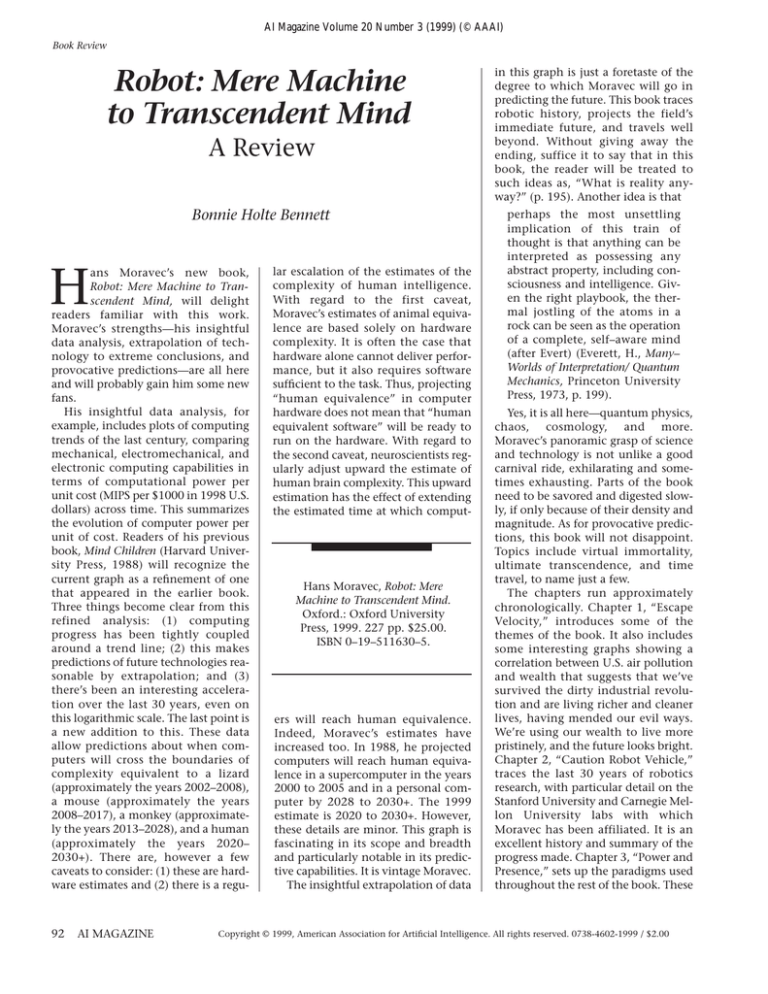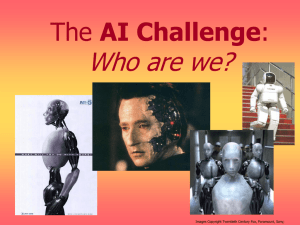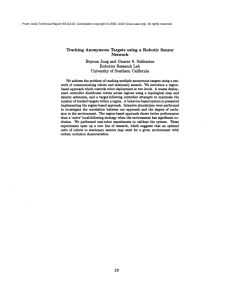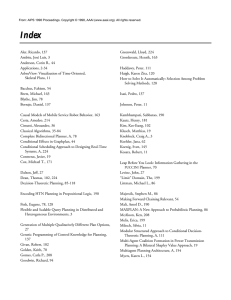
AI Magazine Volume 20 Number 3 (1999) (© AAAI)
Book Review
Robot: Mere Machine
to Transcendent Mind
A Review
Bonnie Holte Bennett
H
ans Moravec’s new book,
Robot: Mere Machine to Transcendent Mind, will delight
readers familiar with this work.
Moravec’s strengths—his insightful
data analysis, extrapolation of technology to extreme conclusions, and
provocative predictions—are all here
and will probably gain him some new
fans.
His insightful data analysis, for
example, includes plots of computing
trends of the last century, comparing
mechanical, electromechanical, and
electronic computing capabilities in
terms of computational power per
unit cost (MIPS per $1000 in 1998 U.S.
dollars) across time. This summarizes
the evolution of computer power per
unit of cost. Readers of his previous
book, Mind Children (Harvard University Press, 1988) will recognize the
current graph as a refinement of one
that appeared in the earlier book.
Three things become clear from this
refined analysis: (1) computing
progress has been tightly coupled
around a trend line; (2) this makes
predictions of future technologies reasonable by extrapolation; and (3)
there’s been an interesting acceleration over the last 30 years, even on
this logarithmic scale. The last point is
a new addition to this. These data
allow predictions about when computers will cross the boundaries of
complexity equivalent to a lizard
(approximately the years 2002–2008),
a mouse (approximately the years
2008–2017), a monkey (approximately the years 2013–2028), and a human
(approximately the years 2020–
2030+). There are, however a few
caveats to consider: (1) these are hardware estimates and (2) there is a regu-
92
AI MAGAZINE
lar escalation of the estimates of the
complexity of human intelligence.
With regard to the first caveat,
Moravec’s estimates of animal equivalence are based solely on hardware
complexity. It is often the case that
hardware alone cannot deliver performance, but it also requires software
sufficient to the task. Thus, projecting
“human equivalence” in computer
hardware does not mean that “human
equivalent software” will be ready to
run on the hardware. With regard to
the second caveat, neuroscientists regularly adjust upward the estimate of
human brain complexity. This upward
estimation has the effect of extending
the estimated time at which comput-
Hans Moravec, Robot: Mere
Machine to Transcendent Mind.
Oxford.: Oxford University
Press, 1999. 227 pp. $25.00.
ISBN 0–19–511630–5.
ers will reach human equivalence.
Indeed, Moravec’s estimates have
increased too. In 1988, he projected
computers will reach human equivalence in a supercomputer in the years
2000 to 2005 and in a personal computer by 2028 to 2030+. The 1999
estimate is 2020 to 2030+. However,
these details are minor. This graph is
fascinating in its scope and breadth
and particularly notable in its predictive capabilities. It is vintage Moravec.
The insightful extrapolation of data
in this graph is just a foretaste of the
degree to which Moravec will go in
predicting the future. This book traces
robotic history, projects the field’s
immediate future, and travels well
beyond. Without giving away the
ending, suffice it to say that in this
book, the reader will be treated to
such ideas as, “What is reality anyway?” (p. 195). Another idea is that
perhaps the most unsettling
implication of this train of
thought is that anything can be
interpreted as possessing any
abstract property, including consciousness and intelligence. Given the right playbook, the thermal jostling of the atoms in a
rock can be seen as the operation
of a complete, self–aware mind
(after Evert) (Everett, H., Many–
Worlds of Interpretation/ Quantum
Mechanics, Princeton University
Press, 1973, p. 199).
Yes, it is all here—quantum physics,
chaos, cosmology, and more.
Moravec’s panoramic grasp of science
and technology is not unlike a good
carnival ride, exhilarating and sometimes exhausting. Parts of the book
need to be savored and digested slowly, if only because of their density and
magnitude. As for provocative predictions, this book will not disappoint.
Topics include virtual immortality,
ultimate transcendence, and time
travel, to name just a few.
The chapters run approximately
chronologically. Chapter 1, “Escape
Velocity,” introduces some of the
themes of the book. It also includes
some interesting graphs showing a
correlation between U.S. air pollution
and wealth that suggests that we’ve
survived the dirty industrial revolution and are living richer and cleaner
lives, having mended our evil ways.
We’re using our wealth to live more
pristinely, and the future looks bright.
Chapter 2, “Caution Robot Vehicle,”
traces the last 30 years of robotics
research, with particular detail on the
Stanford University and Carnegie Mellon University labs with which
Moravec has been affiliated. It is an
excellent history and summary of the
progress made. Chapter 3, “Power and
Presence,” sets up the paradigms used
throughout the rest of the book. These
Copyright © 1999, American Association for Artificial Intelligence. All rights reserved. 0738-4602-1999 / $2.00
Book Review
Call for Papers
The Fifth International Conference on
Artificial Intelligence Planning and Scheduling Systems
(AIPS 2000)
April 14-17, 2000, Breckenridge, Colorado, USA
Co-located with KR 2000, April 12-15, 2000
The International Conference on AI Planning and Scheduling Systems is being held in cooper ation with AAAI and wil l bring together
researchers working on all aspects of planning, scheduling, planning and l earning, and plan execution. The format of the conference will
include paper presentations, invi ted speakers, panel discussions, workshops, and competi tions among implemented planning,
scheduling, and executi on systems. Topics of interest include:
- Planning algorithms
- Planning and learning
- Planning under uncertainty
- Scheduling al gorithms
- Resource management, Mixed-initiative planning
- Plan execution, monitoring and replanning
- Acti ve perception and sensor -based planning
- Applications and domain-specifi c techniques
- Issues in fielding pl anning and scheduling systems
- Planning and reasoning about action and change
- Planning and temporal reasoning
- Decision-theor etic planning
- Constraint management in planning and scheduling
- Multi -agent planning
- Agent architectures for planning and control
- Reactive systems
- Plan and schedule vi sual izati on
- Connections between planning and CSP/OR
The paper Submission Deadl ine is November 1, 1999. The Wor kshop Submission Deadline is December 15, 1999. We plan to
provide special recognition to papers of exceptional quality. For more information on workshops, the main confer ence, and the
competi tions see http://www.isi.edu/aips.
paradigms include the basis for computational complexity; storage and
processing speeds that are delineated
here; and the graph predicting computer growth, along with others documenting chess successes and computational power. Chapter 4, “Universal
Robots,” delineates four generations of
universal robots that will appear over
the next half–century. The final generation includes superrational robots
with emotional displays. Chapter 5,
“The Age of Robots,” chapter 6, “The
Age of Mind,” and chapter 7, “Mind
Fire,” look at the future, beyond the
point where robots surpass human
capabilities. In these chapters are concepts as intriguing as the “synchronous orbital bridge,” which pro-
vides a cheap, clean access to space,
and time travel.
This summary of the chapters leads
to a caution I would make in recommending this book to colleagues.
Some people, for example, my
philosopher friends, might be less
interested in the technical detail. To
them I would say, “Skim chapters 2
and 5; don’t let them bog you down.
You can skip them for now and come
back to them if you want.” For analytic readers, I might encourage them to
start with chapter 3 as a “hook.” The
point is there is something very
rewarding in this book for many people, but the vastness of some sections
might overwhelm them, and it would
be a shame to be lost in the rich dis-
cussion of a personally uninteresting
discipline so that the real reward is
never reached.
Moravec’s work has epic proportions. He engenders provocative discussion and provides daring insight.
His new book is destined to be the
classic his previous book has become.
Bonnie Holte Bennett is director of the
Artificial Intelligence Laboratory and an
associate professor in the Graduate Programs in Software at the University of St.
Thomas.
Her
e-mail
address
is
bhbennett@stthomas.edu.
FALL 1999
93
New Proceedings from AAAI Press
Proceedings of the
Seventh International Conference
on Intelligent Systems for
Molecular Biology
Proceedings of the
Twelfth International Florida
Artificial Intelligence Research
Society Conference
Edited by Thomas Lengauer, Reinhard Schneider,
Peer Bork, Douglas Brutlag, Janice Glasgow,
Hans-Werner Mewes, and Ralf Zimmer
Edited by Amruth Kumar and Ingrid Russell
he ISMB conference series provides a general forum for
disseminating the latest developments in bioinformatics.
ISMB is a multidisciplinary conference that brings together
scientists from computer science, mathematics, molecular
biology, and statistics. Its scope includes the development and
application of advanced computational methods for biological
problems. Relevant computational techniques include
machine learning, pattern recognition, knowledge representation, databases, combinatorics, stochastic modeling, string
and graph algorithms, linguistic methods, robotics, constraint
satisfaction, and parallel computation. Biological areas of
interest include biomolecular structure, genomics, biomolecular sequence analysis, evolution, and phylogenetics, biomolecular interactions, metabolic pathways, regulatory networks,
developmental control, and molecular biology generally.
Emphasis is placed on the validation of methods using real
data sets, on practical applications in the biological sciences,
and on development of novel computational techniques.
T
ISBN 1-57735-083-9
$45.00 softcover
he Florida AI Research Society Conference was founded in
1987 to promote and advance AI research within the state
of Florida, fostering interaction between researchers at colleges, universities, and industry. Since 1990, Florida AI
Research Society conferences have been broadened to include
participants and papers from across North America and the
world. This year's proceedings covers a wide range of topics,
including applications, computer vision, evolutionary computation, intelligent agents, knowledge-based systems, learning
and AI, logic and AI, logic programming, natural language
processing, planning, AI applied to spacecraft autonomy, evolutionary computation, intelligent tutoring systems, knowledge management, neural network applications, parallel and
distributed reasoning, reasoning about function, spatiotemporal reasoning, uncertain reasoning, and verification, validation, and knowledge-base refinement.
T
ISBN 1-57735-080-4
$50.00 softcover
560 pp., illus., index
324 pp., illus., references, index
Published by the AAAI Press
445 Burgess Drive
Menlo Park, California 94025
To order, call 650-328-3123. http://www.aaai.org/Press/
94
AI MAGAZINE




